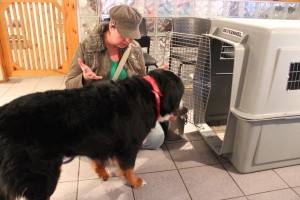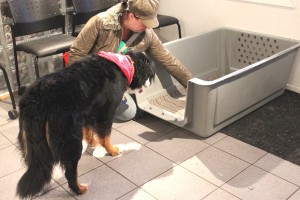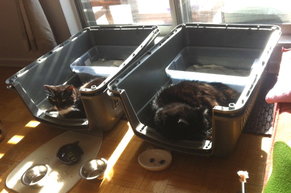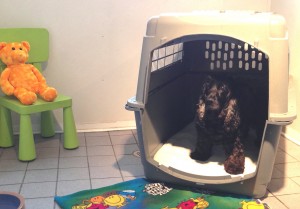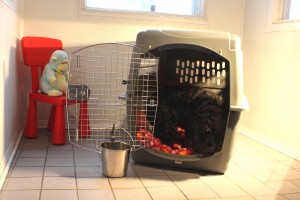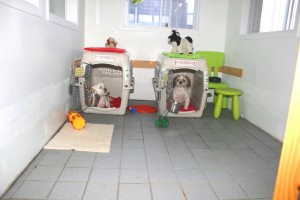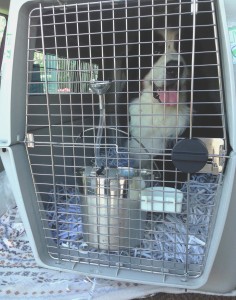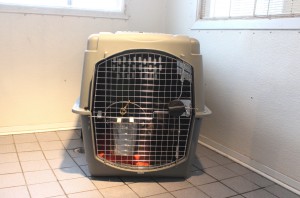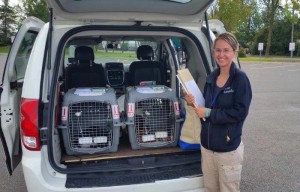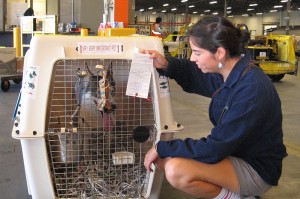“My pet hates going into his air travel crate!”
Try our progressive Travel Crate Training method
Many pets have never been in an air travel crate. They can be uncomfortable when first introduced to a closed door flight kennel. Many dogs or cats will panic, scratch the crate door, make their paws and nails bleed. If such behavior should happen at the air cargo area, the airline may refuse to board your best friend.
To correct this problem use our progressive Travel Crate Training method. Go gradually, make it fun… do not push him/her inside the crate. This method can be done in your own home.
If you encounter difficulties, at Manoir Kanisha we can gradually condition your Best Friend to its flight kennel. This crate conditioning would e done while your pets is boarded at our facilities, just before their relocation date.
You could also purchase the flight kennel from Manoir Kanisha a few weeks before departure and train your animal at home to gradually spend time in the travel crate. Each animal is different. You could plan to train for 3 to 4 weeks or even longer.
We suggest that you gradually train dogs or cats to their Air Travel Crate using the following 6 STEPS.
STEP # 1 : Make a bed in an open crate:
Disassemble the crate and make a nice bed with comfortable polar fleece into the open crate. Place this open crate in his/her preferred sleeping place. Do this for 5 days. Remove all the other comfortable places your pet normally uses to lay down. Place his bed, toys, treats… etc. inside the open crate. Make it fun, be positive. Going into the crate should never be perceived as a punishment but as a pleasure. If he/she resist. you could try with a larger travel crate.
For cats, we suggest you place a little bit of Catnip to motivate him to lay down in the crate.
LEO & LOULOU. Photo provided by Mrs. G. Couture
STEP # 2: Assemble the crate but not the door.
Do this step for 5 days. Feed him/her in the back of the crate. Make sure there is a source of light in the back of the crate (window daylight or lamp) to lit the inside of the crate. Some animal will hesitate to enter a dark or somber crate. A pale color blanket will give the impression of more light inside the crate.
STEP # 3: Install the door but keep it open.
Install the water bucket inside the door but still sitting on the floor. Remove all other water bowls in your house. The animal must learn to drink in this deep water bucket.
STEP # 4… Close the door for short periods.
After each three walks per day, we would place him/her in the crate with the closed door for 15 minutes during a few days. Then, do the same thing 3 times a day for 1 hour, then for 2 hours, then for 3 hours. Then, for a few days place him in his close door crate 2 times per day for 5 hours.
For cats, place a little bit of Catnip inside on his travel crate.
STEP # 5… Sleep complete nights in the crate, door closed:
After the evening brisk walk with your dog or a nice physical playtime session with your cat, place the animal in the crate, door closed for the whole night. Give the pet a treat and gently say “good night”. This is nicely done if the crate is close to your sleeping place. In a few days, move move the crate in the hallway. Then, move the crate to another room. Your pet should sleep comfortably in his/her travel crate during 7 consecutive nights before the scheduled flight.
Ideally, your objective is to make sure your best friend is totally at ease in his travel crate for the same number of hours he will have to spend in it, before, during and after his flight.
For example, for a relocation from Montreal to Amsterdam, you must calculate 4 hours in his crate while waiting at the cargo area before the flight, then 7 hours during the flight and approximatively 3 hours at destination for the customs and Agriculture procedures. This is a total of 14 hours. Therefore, your best friend should spend several sessions inside the crate for a 14-hour periods before his departure date.
STEP # 6… Place the crate in your car or van.
Start making trips with the animal in his travel crate to get him use to being in a “moving” travelling crate. Do this once or twice a day for a few days.
Remember to make it fun! By the end of the STEP # 6, your pet should love his/her travel crate.
Congratulations!
Your BEST FRIEND is now ready for AIR TRAVEL.
———————————-

